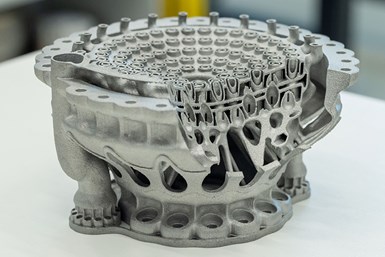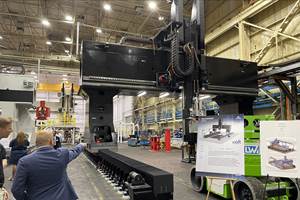AMALLOY Is UAE’s First Locally Developed 3D Printing Alloy
The Technology Innovation Institute says its AMALLOY aluminum alloy powder registers 33% greater strength without compromising on ductility when compared to commercially available AlSi10Mg alloys.
AMALLOY is a new aluminum alloy powder developed by the Technology Innovation Institute (TII) specifically for additive manufacturing (AM). It is the first metal AM feedstock designed in the Middle East for use on laser powder bed fusion (LPBF) systems, offering a low-cost, high-strength aluminum alloy that demonstrates excellent printability and performance.
When compared to commercially available AlSi10Mg alloys,TII says AMALLOY registers 33% greater strength without compromising on ductility. This makes the material well suited for parts where light weight and high strength are a requirement for demanding applications.
Due to the nature of its chemical formulation and intrinsic metallurgical compounds, AMALLOY features an incredibly low hot crack susceptibility coefficient, meaning higher strengths can be achieved without hot cracking issues. Higher strengths are made possible by a robust co-eutectic microstructure combined with a high level of saturation, precipitation hardening and grain refining. In collaboration with Oxford University, Atom Probe Tomography (APT) analyses revealed the presence of nano-precipitates in the primary aluminum microstructure that further enhanced the alloy’s strength.
In addition to the excellent mechanical properties, the alloy has been tested up to temperatures of 300°C, revealing excellent thermal stability and making this grade potentially usable in high-temperature environments.
“Our focus is on developing high strength alloys with excellent printability. We intend to use these new materials in manufacturing defect-free parts to be employed in critical and high-value applications,” says Dr. Nesma Aboulkhair, Director of Additive Manufacturing at TII. “We are adopting a framework for an integrated computational and experimental approach to design and produce these new materials for use in metal AM. This framework constitutes six phases, including alloy design, experimental validation, AM for in situ-alloying with accelerated process optimization, material testing, metal powder optimization and finally, documentation.”
The framework is conducted entirely in-house from start to finish and the company says it has already proven so successful in developing AMALLOY that its has filed for a patent for the alloy with the U.S. Patent Office. TII intends to use the framework to develop new alloys from other families of metals and also expects to use the framework to develop new alloys for traditional manufacturing processes.
“The target clientiele for the new material we are developing for metal 3D printing are worldwide metal powder producers and we are exploring licensing our new patented alloy compositions to global manufacturers,” says Dr. Federico Bosio, lead researcher for additive manufacturing materials at TII. “Some of the use cases that the specific AMALLOY is suitable for include low buy-to-fly parts for aerospace/aviation (such as antennas, aircraft brackets, nanosatellites) and high-strength components such as topology optimized engine brackets.”
AMALLOY will be further enhanced using TII’s development framework, with the aim of producing a high-strength aluminum alloy specifically for high-temperature applications. Once complete, the material will open up new applications across sectors such as aerospace, space, oil and gas, and nuclear.
- For the latest information on new materials in the additive manufacturing industry, visit our Materials section.
Related Content
World’s Largest Metal 3D Printer Seen at Ingersoll Grand Opening Event
Maker of large additive and subtractive machines adds capacity in Rockford, Illinois.
Read MoreAM 101: What Is Binder Jetting? (Includes Video)
Binder jetting requires no support structures, is accurate and repeatable, and is said to eliminate dimensional distortion problems common in some high-heat 3D technologies. Here is a look at how binder jetting works and its benefits for additive manufacturing.
Read MoreWhat is Powder Bed Fusion 3D Printing?
Whether in metal or polymer, with a laser or an electron beam, powder bed fusion (PBF) is one of the most widely used 3D printing techniques.
Read MoreAluminum Gets Its Own Additive Manufacturing Process
Alloy Enterprises’ selective diffusion bonding process is specifically designed for high throughput production of aluminum parts, enabling additive manufacturing to compete with casting.
Read MoreRead Next
Looking to Secure the Supply Chain for Castings? Don't Overlook 3D Printed Sand Cores and Molds
Concerns about casting lead times and costs have many OEMs looking to 3D print parts directly in metal. But don’t overlook the advantages of 3D printed sand cores and molds applied for conventional metal casting, says Humtown leader.
Read MoreVideo: Intelligent Layering Metal 3D Printing at 3DEO
Contract manufacturer 3DEO delivers metal parts using Intelligent Layering, a binder jetting-like 3D printing process the company developed and operates internally. Here’s how it works.
Read More3D Printing Brings Sustainability, Accessibility to Glass Manufacturing
Australian startup Maple Glass Printing has developed a process for extruding glass into artwork, lab implements and architectural elements. Along the way, the company has also found more efficient ways of recycling this material.
Read More












.png;maxWidth=300;quality=90)











